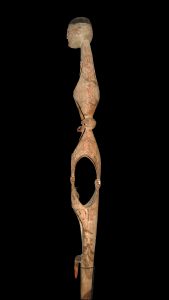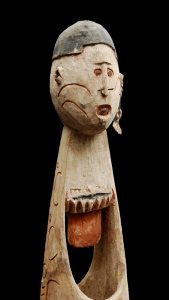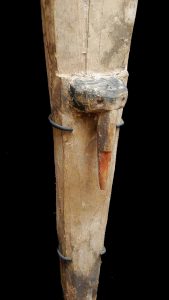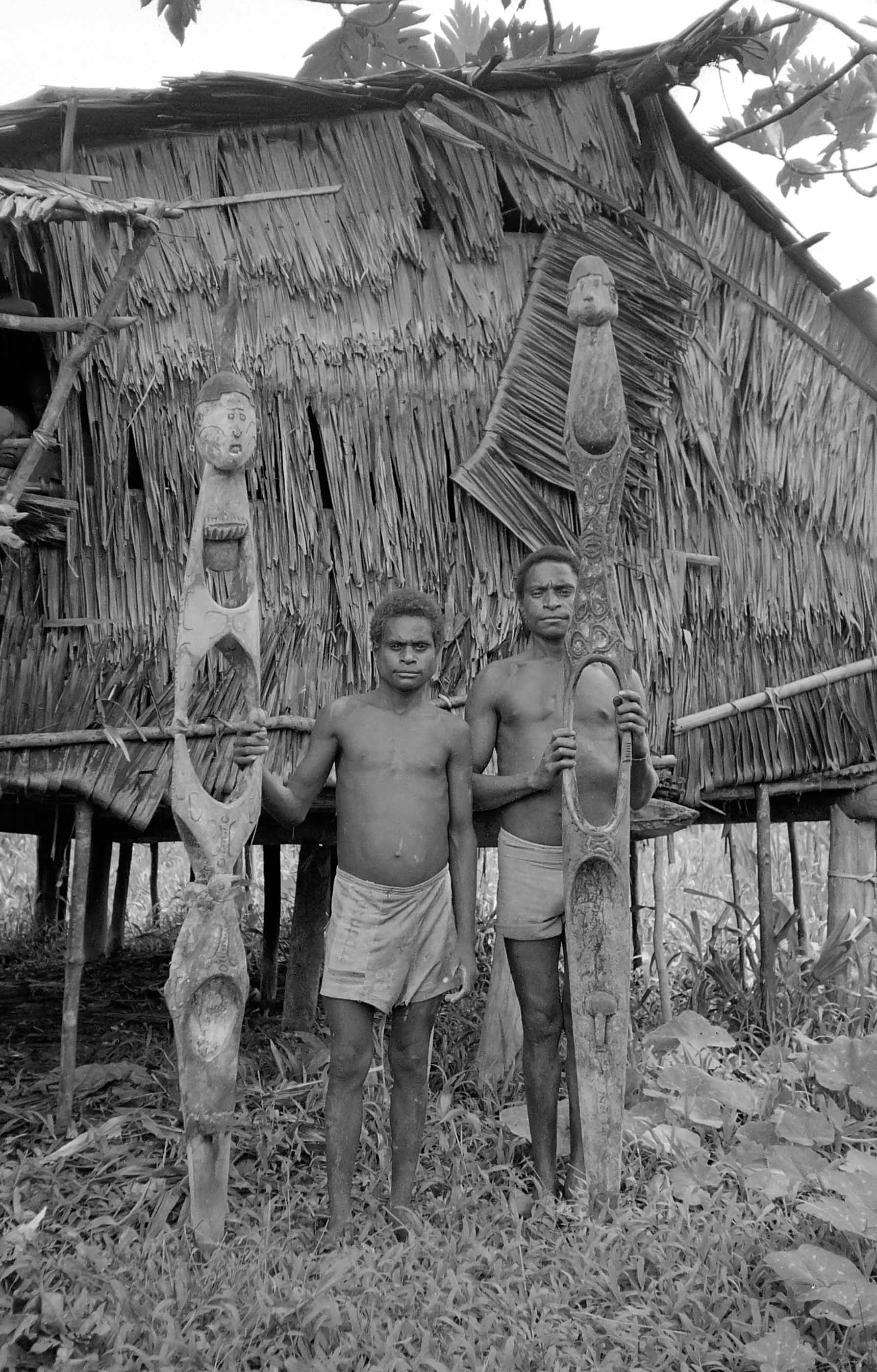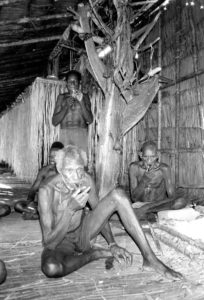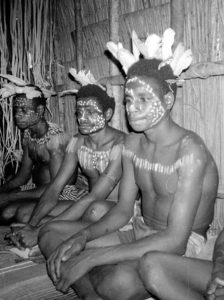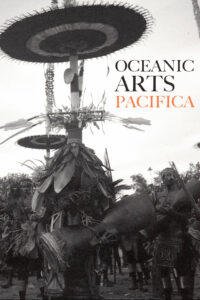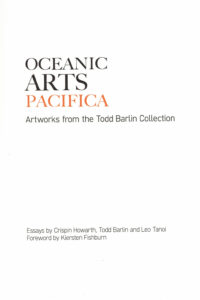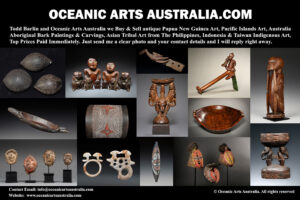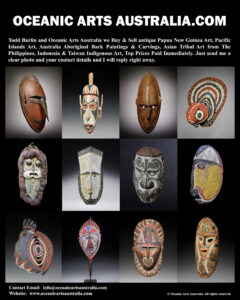A Fine Rare New Guinea Ceremonial Figure Asmat People West Papua Irian Jaya Indonesia
| Collection No. | TB-3412 |
|---|---|
| Size | Height 196 cm |
A Fine Rare New Guinea Ceremonial Figure called Omu Asmat People West Papua Irian Jaya Indonesia
This Omu Ceremonial Figure I collected in 1986 in the remote Northwest Asmat Area on the South Coast of West Papua Irian Jaya Indonesia.
The Omu Ceremony only occurs very infrequently in a few small villages in the remote NW Asmat Area, I was in this Northwest Asmat Area a lot over the years 1985 – 1989, and during that time I was very lucky to see the Omu Ceremonies in several small villages.
According to the Asmat Omu myth, in the beginning, there were two major clans. The spirit named (secret) whispered to the carvers to make Omu bring fertility to the People and keep them from illness. The bottom part of the tree was the father, and the top was the son. Each clan in the village made one Omu that was exchanged with the other clan to promote harmony. This tradition carries on today, with the bottom part now the older brother, and the top the younger brother.
When the elders decide it is time to make Omu, there are several steps in the feast cycle. The village men begin by making a special feast house for the Omu, called the je ti.
Elders and wow-pits or master carvers go the jungle to find one very tall tree, or two suitable shorter trees, as Omu are always made in pairs. The other men prepare logs, bark, and sago leaves for constructing the house. When the Omu is almost finished, colour is applied and their heads are pushed through a curtain for the villagers to look at from a distance. This is repeated several times over the course of the days leading up to the finished product.
Around this time, some men go out hunting wild boar for the feast, while others go back to the jungle to find a mangrove tree with many buttress roots. They cut it down, strip the bark, then shorten the roots and fashion them into hook shapes. The tree is brought to the feast house and is placed upright near the centre of the house at the upstream end. It will serve as a post to help hold up the house, as well as a support for the Omu during the final portion of the feast.
When they are completed, men first, then women, are encouraged to come into the feast house and touch the Omu to ensure fertility. They are accompanied by singing and dancing. Then the Omu is tied to long poles. This portion of the ceremony takes most of one day and all night. The spirits have entered the Omu and will remain with the village to bless it. They are now fed sago and water, and tied to the rafters of the house.
Later two groups of young men sneak in the back door of the feast house, carrying bundles of sago leaves representing headhunting victims. These are placed on either side of the main fireplace. The bundles are poked with spears in a mock attack, and then the leaves are removed from the spines, which are tied back into bundles.
In the photos above you can see photos of some of the people inside the ceremonial house ready for the ceremonial cycles to happen.
Provenance: The Todd Barlin Collection of New Guinea Oceanic Art
I first went to Papua New Guinea in 1985 for an adventure & what I found was that I really enjoyed being with the people of New Guinea, over the next 38 years I spent extensive time spent collecting and documenting traditional art & ceremonies in remote areas of Papua New Guinea & West Papua, The Solomon Islands & Vanuatu & the other Pacific Islands countries. During these travels, I made major collections of New Guinea & Oceanic Art for major Museums and Public Art Galleries
I was honoured by being in the prestigious Louvre Museum Magazine for the collections I made for The Museum of African & Oceanic Art Paris in 1996 (now the Musee Quai Branly) for the exhibition “Asmat et Mimika d’ Irian Jaya April 1996 At THE MUSEE NATIONAL des ARTS D’AFRIQUE et d’ OCEANIE, Paris
See all of the links & photos in my new EXHIBITIONS GALLERY and there is the link to the article in the prestigious Louvre Magazine 1996
I have artwork for Museums & Art Galleries but also for collectors at every stage of their collecting. I want to encourage people to explore the fine art of New Guinea & West Papua and the Pacific Islands and to be able to see and touch the artworks in a relaxed and friendly manner in my Sydney Gallery. I would like to invite you to visit my gallery and see the artworks in person and also look at my website www.oceanicartsaustralia.com where there are many Galleries & Sub Galleries to explore.
My Gallery of nearly 40 years is the last physical gallery in Sydney that specialises in New Guinea & Oceanic Art. Sydney is just a couple hours’ flight to New Guinea & the Pacific Islands where all of these amazing artworks came from, Australia’s closest neighbours.
INQUIRE HERE
To see many more rare items and the finest masterpieces, please make an appointment with us to visit the gallery.
For all inquiries, please contact us.


